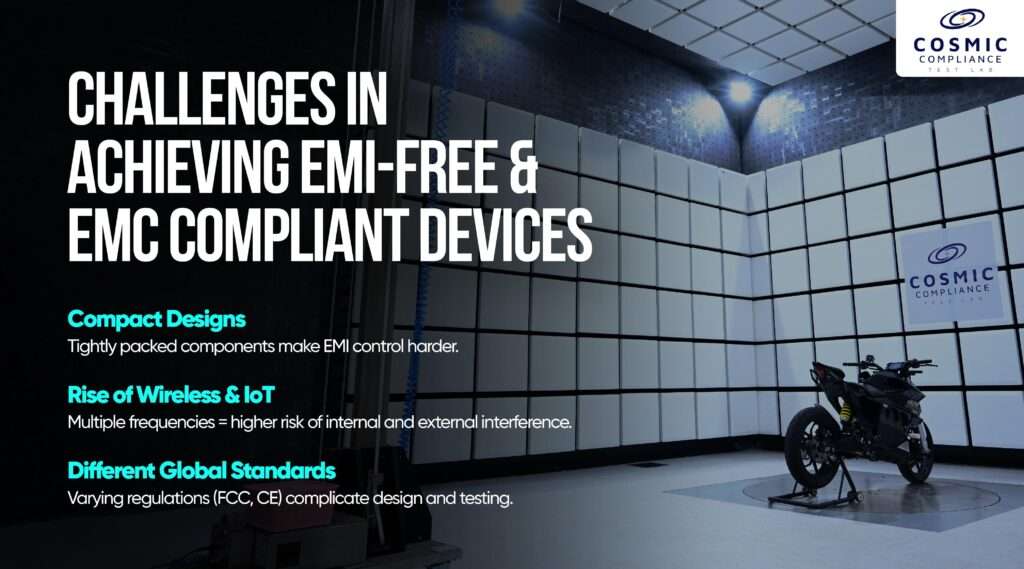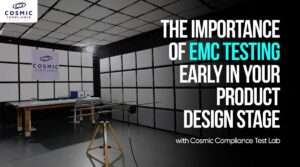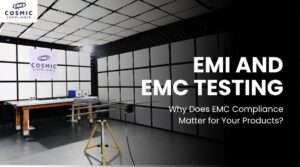Technology is upgrading with each passing day. Electronic devices are getting more convenient but complex. And, any evolution comes with its unique set of challenges. Hence, management of electromagnetic phenomena is essential so that it does not mess up the performance of devices. It is important for devices to work properly. So, you need to consider how they behave within their electromagnetic environment.
The two main concepts to factor in are Electromagnetic Interference (EMI) and Electromagnetic Compatibility (EMC). EMI is any unwanted barrier that affects the performance of devices. And, EMC is like an antidote.It makes sure that a device operates properly within its electromagnetic environment without any obstacles.
Let’s get to know both these concepts better to understand why managing both EMI and EMC are necessary for electronic systems.
What is Electromagnetic Interference (EMI)?
Electromagnetic interference (EMI) is any interference caused by an outside or inside source within a circuit. This disturbance causes the electronics to function poorly or stop working.
EMI can be caused by both outside and inside factors. Natural events like lightning or solar flares can generate high electromagnetic waves. This can result in disturbances in the devices. Man made sources like power grids, electronic devices and wireless communication systems can also affect the functioning of devices.
Essentially there are two types of EMIs, radiated and conducted. When electromagnetic waves travel through air and disturbs the operation of nearby devices it is known as radiated EMI. Conducted EMI, as the name suggests, travels via electrical conductors like wires and cables. This causes disturbances in connected systems.
What is Electromagnetic Compatibility (EMC)?
Electromagnetic Compatibility indicates the electronic devices functioning properly without any interference. It makes sure that devices work correctly in electromagnetic environments without affecting each other’s performance.
There are two main aspects of EMC. Emissions and Immunity. Emission relates to the electromagnetic energy released by a device into its surroundings. These emissions at times can interfere with electronics leading to malfunctioning, Immunity is a device’s ability to tolerate this interference without affecting the device’s performance.
It is critical for any electronic to operate at its best. Well designed systems meet the emi emc testing standards. This reduces the risk of malfunctions.
The Key Differences between EMI and EMC
EMI and EMC both are closely related. But, they address different concerns of electromagnetic phenomena. Let’s understand their main differences.
| Factors | Electromagnetic Interference (EMI) | Electromagnetic Compatibility (EMC) |
| Focus | Centers around disturbances caused by high electromagnetic waves. | Deals with the disturbances or interference caused by waves so that devices function properly. |
| Objective | Aims to minimize the obstacles caused by electromagnetic waves | Enables devices to coexist in electromagnetic environments without causing disruptions |
| Impact on Devices | Can lead to devices malfunctioning, drop in performance levels or even stop working | Makes sure that devices can resist interference and operate correctly |
| Relevance | Attempts to control emissions and reduce interference issues | Keeps balance in emissions and immunity. Aims to meet testing standards |
Why are EMI and EMC critical in electronics design?
EMI and EMC both are critical in the design of electronic systems to maintain performance, functionality and safety. Both these play an important role to create devices that are reliable and function efficiently in electromagnetic environments.
An uncontrolled EMI can greatly affect a device’s performance. This can cause signal loss, malfunction or complete system’s failure. It helps devices work smoothly in atmospheres where multiple systems function simultaneously. These systems include smartphones, machinery or critical infrastructures.
Safety is a big concern when using electronic devices. EMI can cause dangerous situations especially in the case of medical and automotive devices. For example, any malfunction with a pacemaker can cost a patient their life. Similarly in automotive, EMI can lead to accidents. Therefore, It reduces these risks by following proper safety standards.
Why is it required for EMC and EMI to comply with Industry Standards?
Both EMI and EMC are required to follow industry standards. Compliance with the standards ensures safe operation of the devices.
EMI Standards
EMI needs to comply with standards like the International Special Committee on Radio Interference (CISPR), International Electrotechnical Commission ( IEC ) , and Federal Communications Commission ( FCC). These standards set a permissible limit to electromagnetic emission from devices. Incase of failure to meet these standards, it can result in consequences. Like, huge fines, exclusion from the market, and product recall.
EMC Standards
EMC standards include CE marking and UL certification. This standard makes sure that devices work without causing electromagnetic disturbance. The products need to comply with legal and regulatory requirements. This is important to achieve market trust.
Strategies for Minimizing EMI in Electronics
For devices to function at their best and reduce any unwanted situations, we need to minimize EMI. Some strategies that can help you manage EMI,
| Strategy | Description |
| Shielding | Materials like metal enclosures, conductive coating and shields can block radiated EMI. It absorbs or reflects electromagnetic waves and protects the system. |
| Filtering | Low pass or High pass EMI filters can reduce EMI on power lines and cables. The fillers stop unwanted frequencies from going in and out of the device. |
| Grounding | Proper grounding reduces noise. It cleans signal flow and reduces EMI in sensitive circuits. |
| Layout and Design Considerations | Optimizing Printed Circuit Board (PCB) can minimize internal sources of EMI. It includes spearting high and low frequency circuits. |
Ensuring EMC in Electronic Devices
By now, you know how important EMC is for any device. So, how do you ensure EMC in electronic devices?
Design for Immunity
To make your device immune to interferences, efficient components, grounding methods and filters are necessary. Shielding and PCB is also important to prevent disturbances and maintain performance.
Testing for EMC
EMC testing makes sure that devices are following standards. This helps systems perform well in real world conditions. Testing methods like radiated emissions testing, conducted testing and immunity testing is pivotal.
Common Challenges in Achieving EMI-Free and EMC-Compliant Devices

- Devices are getting smaller and compact. This means it is packed intricately with components, hence, more prone to EMI issues. Congested space makes it difficult to integrate shielding and other EMI reduction methods.
- Wireless technologies and IoT devices are making management of EMI more complicated. These devices function on multiple frequency bands. This increases risk of both inside and outside interference.
- EMC and EMI standards vary depending on geographical regions. Like FCC in the U.S. or CE marking in Europe. Multiple regulations can complicate the design and testing process.
Future Trends in EMI and EMC Management
As technology is evolving and devices getting more complex, better EMI and EMC management is essential. AI and machine learning can be leveraged to identify the challenges with EMC and EMI.
Mart technologies like 5G and IoT will require even more sophisticated handling of EMI and EMC. The next generation will for sure demand an enhanced EMC standard to work smoothly in interconnected environments.
Conclusion
EMI and EMC are both related but different phenomena. While EMI strictly works to reduce interference, EMC makes sure that devices can co exist in the same environment and work efficiently.
Hence, monitoring both EMI and EMC is necessary for a system’s performance and safety. Proper management of EMI lowers the risk of malfunctions and hazards. EMC complies with the standards and guarantees devices work correctly in real life circumstances.
Take action now and prioritize EMI and EMC concerns early in your design process. This will help create a product that is reliable, compliant with standards and market ready. Work closely with experts with emi emc testing in bangalore and handle challenges with ease. Get in touch with trusted service providers for emi emc certification, and build electronics that excel in performance today!





